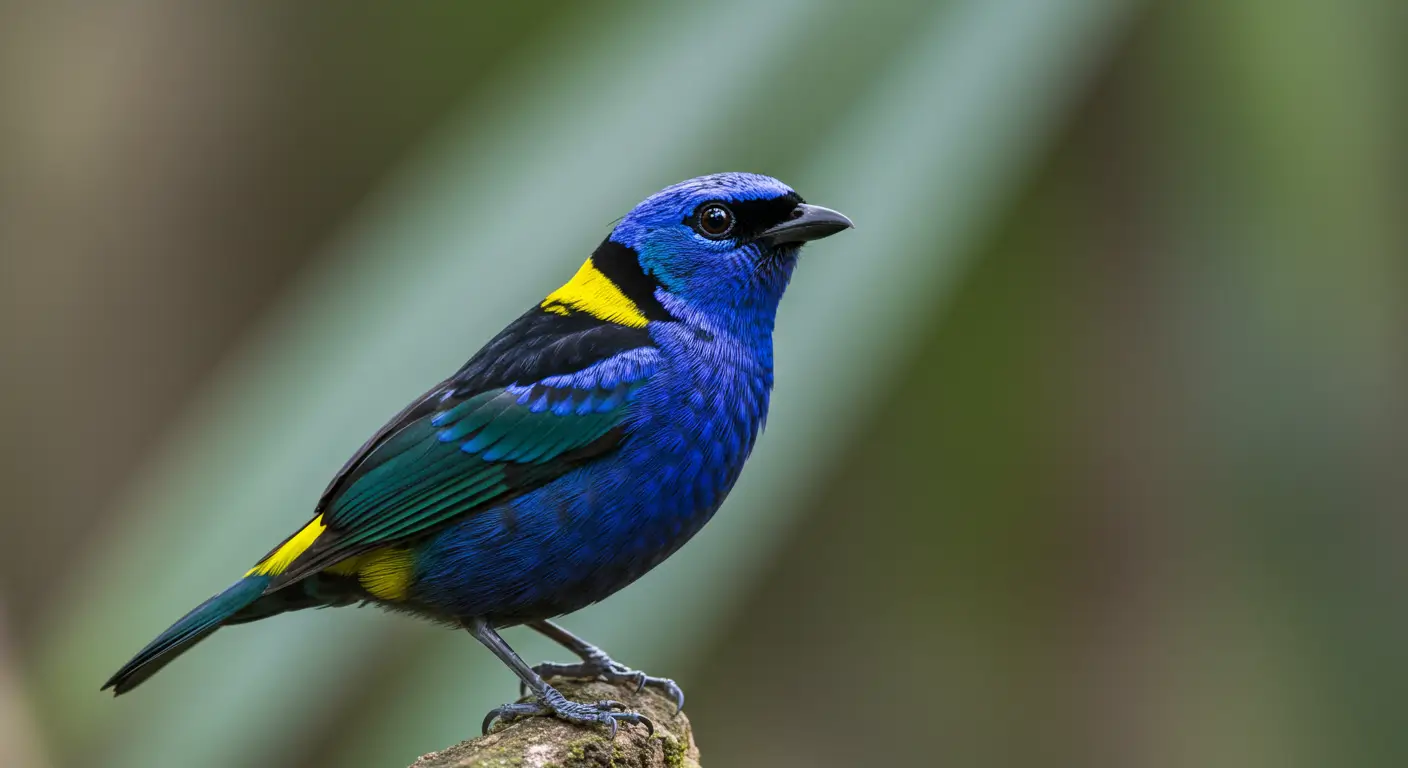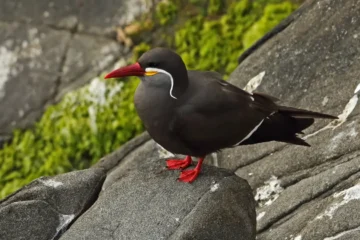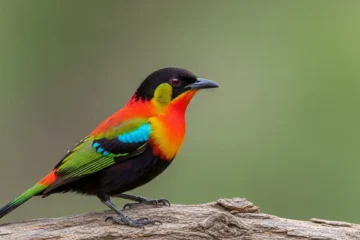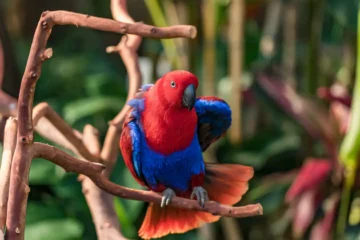The Paradise Tanager is a brightly colored songbird found in South America for its unique look. It has green, blue, red, and black feathers that make it look like a living rainbow. This bird lives mostly in tropical forests and feeds on fruit and insects.
It’s small and fast bird which is often seen in groups. Birdwatchers admire its quiet song and bold colors. It’s not endangered, but its rainforest home is shrinking.
Images of Paradise Tanager
Price of Paradise Tanager
A Paradise Tanager typically costs between $850 and $1,200 in the USA. The price depends on the bird’s age, health, and breeder reputation.

General Characteristics of Paradise Tanager
This bird is no less than seeing a live rainbow in the form of an attractive bird. Here are certain characteristics of this bird which makes it unique among others:
| General Characteristic | Paradise Tanager Feature |
| Scientific Name | Tangara chilensis |
| Appearance | Bright green head, sky-blue belly, and multicolored back |
| Size | Grows up to 5.5 inches in length |
| Weight | Weighs about 14–18 grams |
| Color Pattern | Neon green, turquoise, black, red or yellow tones |
| Diet | Eats fruits, insects, and small arthropods |
| Beak Shape | Short, strong, and slightly curved |
| Habitat | Lives in humid, tropical lowland forests |
| Vocalization | High-pitched chirps and soft whistles |

LifeSpan of Paradise Tanager
A Paradise Tanager lives about 5–7 years in the wild. This bird can live up to 12 years in the captivity being provided proper care.

Interesting Facts Related to Paradise Tanager
This bird is quite silent than other birds and also have some unique qualities which can attract people. Here are some interesting facts related to this bird:
1. Neon-Green Head Looking Unreal in Photos
The Paradise Tanager has a neon-green head that almost glows in the sunlight. This effect is due to microscopic feather structures and not the pigments.
This bird often gets highlighted for its unreal beauty. Its head color contrasts sharply with its multi-colored body.
2. Change Slightly in Color by Region
Their rump color changes depending on their home range. Some have bright yellow rumps while others have sky blue. It also adds an extra challenge for birdwatchers traveling to spot them.
Color variation helps scientists track their distribution in the wild.

3. Voice Is Rarely Heard
This bird’s vocalizations are not well studied unlike others. This has created a bit of a mystery among bird call collectors. The few recordings that exist reveal soft and high-pitched whistles.
Its quiet nature adds to its marked reputation.
4. Have a Very Specialized Fruit-Only Diet
Paradise Tanagers eat almost entirely fruit unlike other birds that eat a mix of seeds and insects. Their digestive system is optimized for quick fruit processing. They prefer soft and tropical fruits like papayas and figs.
American zoos that house them must import or grow specific fruits to match their diet. Their feeding habits limit where they can survive.
5. Nesting Behavior Is Largely Unknown
Their nesting habits are still a mystery. They likely build nests high in dense canopies which makes them hard to observe. This lack of data frustrates scientists who study tropical species.
6. Acts as a Seed Spreader in Amazon Rainforest
This bird plays a big role in spreading seeds of tropical fruit trees. Its ecosystem service supports global biodiversity. It helps maintain forest structure by moving seeds across forest patches. The disappearance would reduce natural plant regeneration.

7. The Feathers Are Iridescent
Their feathers appear to change shades when seen from different angles. This optical effect is called iridescence and isn’t caused by pigment. It’s the same phenomenon seen in peacocks and hummingbirds.
U.S. biologists study these light-reflecting feather structures for material science inspiration. The effect gives the bird a dynamic look in motion.
8. Paradise Tanagers Don’t Migrate Seasonally
Paradise Tanagers do not migrate and live in warm climates year-round. This behavior gives scientists insights into non-migratory life cycles. Their sedentary life affects how they respond to habitat changes.
9. Lives Mostly in the Upper Canopy Layer
Paradise Tanagers prefer the top layers of tall rainforest trees. This makes them very difficult to observe in the wild, even in their native regions. The birdwatchers often use high-powered binoculars and canopy towers to spot them.

This vertical bhavior limits their exposure to predators.
10. Often Travel in Mixed-Species Flocks
The Paradise Tanager frequently joins flocks with other species. These flocks provide safety and improve searching efficiency. American researchers study these groupings to understand interspecies communication.
It shows that birds can cooperate beyond their own kind. These flocks often include other tanagers and tropical insectivores.
11. Bright Colors Serve as Camouflage
Their rainbow feathers help them blend into the forest’s dappled light. Bright patches actually make them harder to detect in the complex light patterns of the canopy.
Their colors confuse predators rather than attract them. It’s an adaptation unique to their environment.
12. Artists and Designers Use Its Colors
The Paradise Tanager’s vivid palette influences fashion, textile, and graphic design. The use of its natural color scheme to create attractive visual themes. It often appears in bird-themed illustrations and eco-conscious brands.
Art schools reference it when teaching about contrast and harmony. Its natural colors provide a live lesson in effective color theory.

Sightseeings of Paradise Tanager
These birds are not oftenly seen at different places in the USA and the public only gets the opportunity to see them in public parks.
If you get a chance of getting good clicks of this bird, then you should never miss it. Here are some tips to get good clicks of this bird: Use a telephoto lens (300mm or more) to capture clear shots from a distance without scaring the bird. Shoot early in the morning when the light is soft and the bird is more active. Focus on the bird’s eye to keep the photo sharp and full of life. Use a fast shutter speed (1/1000s or higher) to freeze quick movements and wing flaps. Choose a quiet forested area with fruiting trees to increase your chances of seeing one. Set your camera to burst mode to catch quick and unexpected poses. Stay patient and wear muted colors to blend into the environment while waiting. This bird is a silent one among all the bird species and presents a natural beauty through its feathers. The bird catches the attention of people naturally by mimicking the natural beauty of the rainforests and canopies. It eats fruit, insects, and small invertebrates found in tropical forests. Its bright colors help it blend into the rainforest and may attract mates. It’s a small bird, about 13–15 cm long which roughly mimicks the size of a sparrow. No, it’s listed as Least Concern, but deforestation threatens its habitat.
Location
State in Which it is Located
San Diego Zoo
California
Dallas World Aquarium
Texas
Smithsonian National Zoo
Washington, D.C.
Bronx Zoo
New York
Saint Louis Zoo
Missouri
Denver Zoo
Colorado
Columbus Zoo and Aquarium
Ohio
Los Angeles Zoo
California

Photography Tips to Get Good Clicks of Paradise Tanager

Most Asked Questions
1. What does the Paradise Tanager eat?
2. Why is the Paradise Tanager so colorful
3. How big is a Paradise Tanager?
4. Is the Paradise Tanager endangered?










